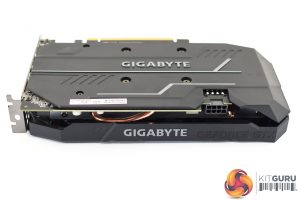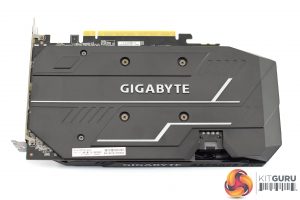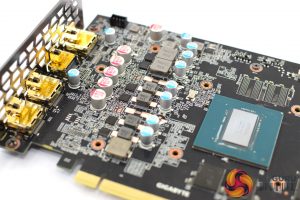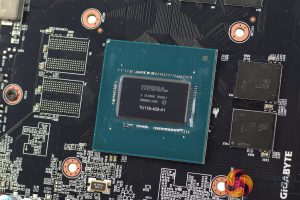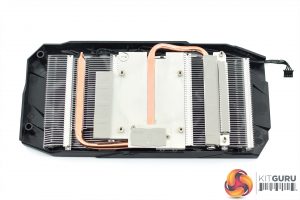The Gigabyte GTX 1660 Ti OC 6G ships in a dark box, with an image of a large robotic eye taking up most of the front of the box.
Inside, we get little in the way of accessories – there's just a quick start guide and a driver disk.
The card itself looks very similar to other Gigabyte models we have seen recently, with a black plastic shroud and two grey sections. It's pretty plain-looking and nothing that exciting, but at the same time it's also very colour neutral so isn't going to cause issues with a colour coordinated build.
The fans which form the ‘Windforce X2' cooling system measure 90mm in diameter. Interestingly, they both spin in different directions – the left fan spins counter-clockwise, the right fan spins clockwise. Gigabyte says this reduces turbulence and increases airflow pressure, and we will look at thermals later on in the review.
In terms of dimensions, the OC 6G is a very compact card – not as dinky as some of the single-fan 1660 Ti models on the market, but for a dual-fan cooler it is not big at all. Official dimensions are 225.65 x 122.02 x 40.5 mm, meaning it is a standard dual-slot thickness. Under 23cm in length, too, means this should fit in pretty much any case on the market.
On the front side of the card, we can see the plastic shroud wraps round and almost meets the backplate. The Gigabyte logo is printed here in grey text, and it's also worth pointing out there is no RGB lighting on this card at all. That may well appeal to some people, but it may also put off some others.
Personally I am not too bothered either way – a card like this is really all about bang-for-buck, so the RGB is just going to increase the cost, and I think most gamers would rather have an enhanced cooler or factory overclock than RGB at this price point.
As for the backplate, this is actually made of plastic, not metal. That, coupled with the fact it doesn't actually contact the back of the PCB, means it isn't going to provide any cooling for the PCB, but instead it is for aesthetics and also to provide a bit of structural support to the card.
I think it looks pretty good, again it's nothing special, but it is definitely better than looking at an uncovered PCB, while it will also provide some protection from any possible water leakage from a liquid cooler.
In terms of power requirements, the OC 6G sticks to reference spec as it only needs 1x 8-pin PCIe power connector.
Display I/O is also very standard, with 3x DisplayPort and 1x HDMI outputs.
Taking the card apart is very easy – just six screws need to be removed from the back and then we get direct access to the PCB. Gigabyte has opted for a 4-phase solution for the GPU VRM, and 2-phase solution for the GDDR6 memory – the same configuration as MSI's Gaming X card.
The GPU is labelled ‘TU116-400-A1', and remember there is only one TU116 chip – Nvidia is not pre-binning the GPUs into ‘A' and ‘non-A' stacks as it does with the RTX 20-series. The 6GB GDDR6 memory comes from Micron, with the chips labelled ‘DZ177D9WCR'.
As for the cooler and heatsink, this is about as basic as it gets. Gigabyte has used a single fin stack, with just one 6mm copper heatpipe that makes direct contact with the GPU. This pipe runs through a coldplate which cools the VRAM chips, while there is also a smaller coldplate for VRM.
It's clearly not much of a cooler, but then I did mention in my launch-day GTX 1660 Ti review that TU116 does not need much in the way of cooling. Whether or not Gigabyte's solution is enough, however, we will get to later in the review.
 KitGuru KitGuru.net – Tech News | Hardware News | Hardware Reviews | IOS | Mobile | Gaming | Graphics Cards
KitGuru KitGuru.net – Tech News | Hardware News | Hardware Reviews | IOS | Mobile | Gaming | Graphics Cards








